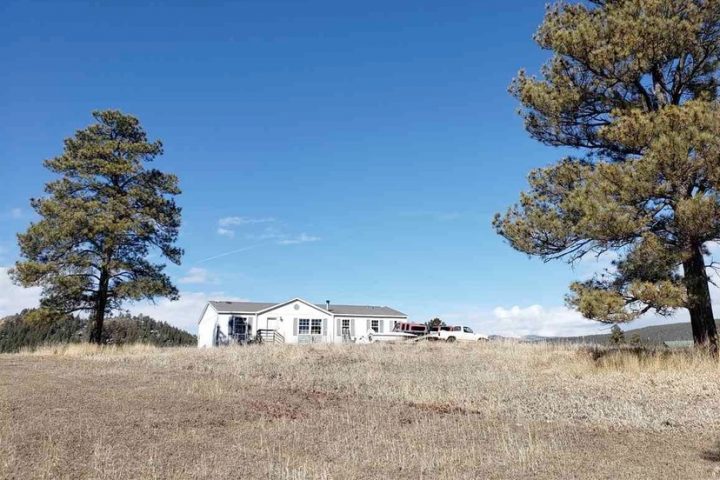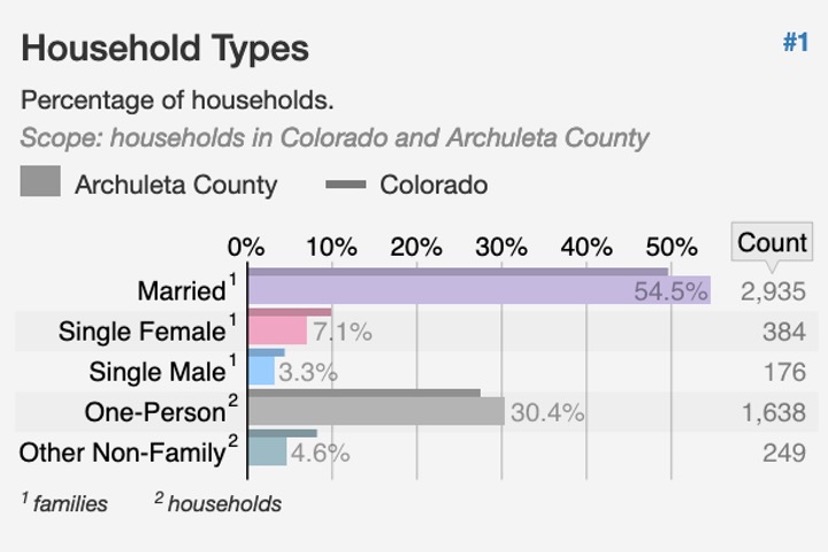The biggest surge is in high-end properties of $1 million or more. This is surprising, because this was the slowest sector for years. We have more than doubled last year’s sales of 7 in this category. This year we have 15, and we’ve got 7 more in the hopper. If this trend continues, we’ll sell three times as many million dollar homes as we usually do…
— from realtor Lee Riley’s September 7, 2020 real estate report.
Is prosperity killing the town I love? And if so, do our community leaders understand what’s going on… and are they willing to do anything about it?
When I wrote Part Seven, yesterday, and researched the number of Archuleta County homes that might be affordable to a family earning the “MFI” for our community — the “Median Family Income” as defined by the US Department of Housing and Urban Development (HUD) — it appeared that a family earning the median income of $58,400 per year had a choice of about 14 affordable homes on the current Pagosa real estate market… out of about 250 homes on the market.
I had checked the ‘affordability’ limits for such a family using the mortgage calculator on the Colorado Housing and Finance Authority (CHFA) website.
I’m as skeptical about government-generated data as anyone, but it’s the world we live in. For another dose of government numbers, I visited the website called StatisticalAtlas.com, operated by Cedar Lake Ventures, Inc. The website pulls data from US Census Bureau “tracts” and converts the data into easy-to-read maps and graphs. One of its data pages revealed the types of households we have here in Archuleta County.
About 30% of our households are “one-person” households, without children.That’s a slightly higher percentage than in Colorado overall (the narrow bar shown above each Archuleta County bar.) 7.1% are single moms; 3.3% are single dads. So then, a total of about 560 single-parent households. About 55% are married families with or without children.
A total of about 5,382 households, if we can believe the US Census Bureau.
And if we can believe HUD, half of those households have incomes in excess of $58,400, and can afford — if we can believe CHFA — one of the 14 homes currently listed on the Colorado Real Estate Network (CREN) database as priced at $242,000 or less.
That price — $242,000 — is the maximum mortgage amount that a family, with a good credit history, a down payment, and an income of $58,400, could qualify for… according to CHFA.
To put this government and real estate data into a certain kind of perspective…
Half of the families currently living in Archuleta County — about 2,690 families — could presumably afford to purchase one of those 14 reasonably-priced homes currently listed on CREN if they happened to be in the market for a house.
But… about 2,690 families earn less than $58,400 per year, and do not meet the CHFA threshold for a home priced at $242,000.
According to Mr. Riley’s September 7 real estate summary, it looks like Pagosa Springs real estate brokers, this year, might sell as many as 20 homes priced at more than $1 million…
…while we have 2,690 families who likely would struggle to afford one of the 14 “homes priced under $242,000” here in Archuleta County.

This data is something of a revelation for me, considering that I’ve been writing occasionally about Pagosa’s housing crisis for the past 16 years, but had never found an information source — like the one from StatisticalAtlas.com, above — that broke down the number of families in my community by family type.
The non-profit housing group Pagosa Housing Partners spent much of 2018 researching the housing crisis here in Archuleta County, and then published a 54-page ‘Roadmap to Affordable Housing’ about the situation. (You can download that report here.) Their work was funded by the Town of Pagosa Springs, while the Archuleta Board of County Commissioners refused to provide funding, in spite of a previous agreement to cooperate with the Town on the funding of housing research. The County’s share would have been about $25,000.
(Instead, the County built a $14 million jail that the voters had twice rejected at the polls. But I suppose a jail is a certain type of housing.)
The Pagosa Housing Partners ‘Roadmap’ did not include the data I’ve quoted above regarding family types and family incomes. But the report did look at which parts of our community are suffering most during the housing crisis.
Of course, this report was written ‘pre-COVID’. We are now living a new normal. Or a new abnormal.
Here’s some (now-outdated) data from the PHP survey of our Archuleta County workforce — the folks the Town Council purportedly wants to help, somehow, to obtain affordable ‘workforce’ housing.
National housing organizations typically recommend that individuals and families should not pay more than 30 percent of their household income (before taxes) for housing costs, which includes mortgage or rent, utilities, taxes and insurance. The PHP survey suggests that more than half of Archuleta County households are paying more than the recommended 30% on housing. In the housing assistance business, these households are referred to as “cost burdened.” A household is particularly “burdened” if their housing costs exceed 50% of family income.
But the stress is not evenly distributed among the various income levels.
What the chart above illustrates is that none of the surveyed Archuleta County households making more than $5,000 a month are cost burdened. We could have guessed that.
But of the 81 households earning less than $2000 a month, 14 of them had no permanent housing — they were living in tents, cars or staying with friends or relatives. That’s 17 percent of the survey respondents in that income category. If this survey represented an accurate cross-section of Archuleta County — and that’s admittedly a big ‘If’ — then nearly one-in-five of our lowest paid employees have no permanent housing.
Pile on top of this 2019 data, the effects of the 2020 COVID economy — and local unemployment numbers that exceed 10% of the community’s workforce….
… and “prosperity” seems far, far away for a large number of our neighbors.



